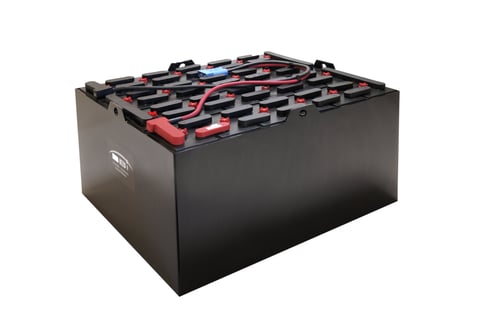
Understanding Depth of Discharge in Forklift Batteries
Introduction: The Heart of Your Forklift’s Power
When it comes to powering your forklift, the battery is the unsung hero behind its robust performance. Among the many factors that affect battery life and efficiency, Depth of Discharge (DoD) stands out as a critical element that every forklift operator should comprehend. Understanding Depth of Discharge in Forklift Batteries can lead to better decision-making regarding maintenance, performance, 18 volt flat plate forklift batteries and overall cost-effectiveness.
So, what exactly is Depth of Discharge? To put it simply, DoD refers to the percentage of energy that has been used from a battery relative to its total capacity. For instance, if you have a forklift battery rated at 100Ah and you’ve used 40Ah, then the DoD is 40%. Keeping an eye on this metric not only helps in ensuring optimal performance but also extends the life span of your batteries.
Understanding Depth of Discharge in Forklift Batteries
The concept of Depth of Discharge isn't just technical jargon—it's crucial for anyone who relies on forklifts for their daily operations. In essence, DoD indicates how much energy you've drawn from your battery over time.
Why Is Depth of Discharge Important?
Understanding Depth of Discharge in Forklift Batteries has several significant implications:
Battery Lifespan: Regularly discharging a battery beyond its recommended DoD can lead to premature aging and reduce its lifespan significantly. Most manufacturers recommend that lead-acid batteries should not be discharged below 50% DoD.
Operational Efficiency: Knowing your DoD can help you optimize operational efficiency. If your workforce consistently runs batteries close to full discharge, you may want to rethink your charging strategy or even consider investing in additional batteries.
Cost-Effectiveness: By managing DoD effectively, you can minimize replacement costs associated with worn-out batteries and improve overall productivity by ensuring your forklifts are ready when needed.
The Chemistry Behind It
What happens inside a forklift battery when it's discharged? In lead-acid batteries—commonly used in forklifts—the chemical reaction reverses during discharge and recharge cycles. Each time you discharge a battery more than its recommended DoD level, you're putting more strain on these chemical reactions.
-
Chemical processes at work: When a battery discharges, sulfuric acid reacts with lead plates to produce lead sulfate and water. While this process is reversible during recharging, excessive discharging leads to sulfation—a condition where lead sulfate crystals form on the plates, making them less effective over time.
-
Impact on performance: A higher DoD may yield increased voltage drop across terminals during operation, resulting in reduced power available for your forklift's motor.
Recommended Practices for Managing DoD
To maintain optimal health for your forklift batteries:
-
Charge Regularly: Avoid letting your batteries reach excessive DoD levels before recharging.
-
Use Battery Monitoring Systems: These systems can provide real-time insights into the state-of-charge (SoC) and depth of discharge levels.
-
Educate Your Team: Make sure all operators understand the importance of monitoring battery usage to avoid deep discharges.
Factors Influencing Depth of Discharge in Forklift Batteries
While understanding DoD is essential, knowing what 72 volt flat plate forklift batteries affects it can further enhance your operational efficiency. Here are some key factors:
Battery Type
Different types of forklift batteries have varying tolerances for depth of discharge:
-
Lead-Acid Batteries: Typically should not be discharged beyond 50% DoD.
-
Lithium-Ion Batteries: These newer technology options can often handle deeper discharges without significant degradation—sometimes allowing up to 80% or more.
Operational Habits
How do operators use forklifts? Factors such as load weight and frequency of use play significant roles in determining how deeply you'll need to discharge your batteries.
Load Weight: Heavier loads demand more energy from the battery which could accelerate depth discharge rates.
Usage Frequency: Continuous operation without adequate breaks will naturally draw down the battery faster than intermittent usage would.
Environmental Conditions
Believe it or not, weather conditions can have an impact too! Extreme temperatures—whether hot or cold—can affect battery performance and longevity which subsequently influences depth discharge levels.
| Environmental Factor | Impact on Battery | |----------------------|-------------------| | High Temperatures | Can cause overheating; may increase discharge rate | | Low Temperatures | Slows down chemical reactions; may reduce capacity |
FAQs About Depth of Discharge in Forklift Batteries
Q1: What is considered a safe Depth of Discharge for forklift batteries?
A1: For lead-acid batteries, it's generally advisable not to exceed a 50% depth of discharge; lithium-ion types can handle deeper discharges up to about 80%.
Q2: How does high Depth of Discharge affect my forklift's performance?
A2: Exceeding recommended DoD levels can lead to reduced voltage available at terminals causing sluggish performance or even failure during operation.
Q3: Can I extend my forklift battery's life by managing its Depth of Discharge?
A3: Absolutely! Proper management minimizes wear and tear on the battery reducing maintenance costs and extending lifespan significantly.
Q4: Should I invest in a monitoring system for my forklift batteries?
A4: Yes! Battery monitoring systems provide valuable insights into SoC and DoD allowing for proactive maintenance strategies that save time and money.
Q5: How often should I charge my forklift batteries?
A5: Ideally after each shift or when reaching approximately 30% remaining capacity unless specified otherwise by the manufacturer guidelines.
Q6: What common mistakes should I avoid regarding Depth of Discharge?
A6: Avoid deep discharges regularly; failing to charge after each use; neglecting temperature considerations; overlooking signs like slow lift speed indicating low power levels.
Conclusion
In summary, understanding Depth of Discharge in Forklift Batteries isn't just about numbers—it's about taking proactive measures that ensure safety, efficiency, and long-term cost savings. By keeping an eye on how deeply you're discharging your batteries while considering factors like type, operational habits, and environmental conditions, you'll position yourself—and your fleet—for success!
Embrace these practices today for better tomorrow’s outcomes with your operational equipment—and keep those forklifts running strong!
